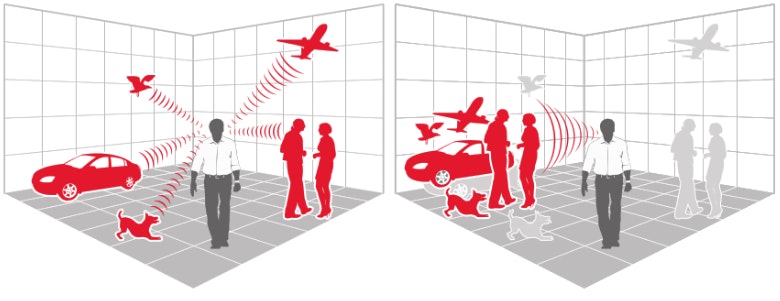Hearing Loss in One Ear
Do you have significant hearing loss in one ear? Does it feel like you can’t tell where sounds are coming from?
Are you able to understand one-on-one conversations in quiet but get lost in background noise?

You are not alone. Hearing loss in just one ear—known as unilateral hearing loss or single-sided deafness—is surprisingly common.
If your connection to your family and friends is being affected by single-sided deafness, don’t give up hope. There is a new option to help restore your ability to hear with both ears.
"Hearing with only one ear is like living in a black and white world, without knowing that somewhere else colors exist."

Burden of Single-Sided Deafness
Often, people with single-sided deafness can follow conversations in quiet settings. This can give your friends and family the impression that your hearing loss is only a minor issue. But single-sided deafness has a significant impact on your quality of life and should be recognized as a serious burden.
Listening with only one ear takes so much more mental effort to separate what you want to hear from background noise. You can’t tell where sounds are coming from, which can make you feel disoriented and overwhelmed.
This can leave you struggling to follow conversations at work, or always having to turn your hearing ear to understand a friend, or worrying that you won’t notice sudden warning noises when crossing the street.
Even with “one good ear,” everyday life with single-sided deafness can be exhausting. Hearing loss doesn’t just make communication difficult—it puts a significant burden on your personal relationships. Often, people with hearing loss withdraw from friends and family and avoid social interaction.
If you find your everyday life, your career, and your relationships are being affected by your hearing loss, don’t give up hope. There is an effective treatment option that is approved to help restore your ability to hear with both ears.
Why is hearing loss in one ear such a burden?
- Hard to follow group conversations
- Can’t tell where sounds are coming from
- More mental effort needed to listen
- Exhaustion from listening effort
- Anxiety in noisy places
- Negative impact on relationships
- Difficulties at work and social gatherings
- Anxiety of losing hearing in good ear

Restoring Binaural Hearing
Why is hearing with both ears so important? In natural hearing, we hear sounds with two separate ears, which is known as binaural hearing.
Our brains compare and interpret these two separate sound signals to let us hear in 3D. This is important because this lets our brains actively focus on what we want to hear while filtering out background noise.
If you take away hearing from one ear, all those sounds become “shapeless.” This is why single-sided deafness makes hearing so difficult in so many situations.
Binaural Hearing
Monaural Hearing

Binaural Hearing and Single-Sided Deafness (SSD)
If you’ve already sought treatment for single-sided deafness, your audiologist may have recommended trying CROS hearing aids. CROS hearing aids send sounds from a microphone in your deafened ear to a hearing aid in your hearing ear.
This can offer some benefit by reducing the “head shadow” effect, which can help you notice more sounds and help with speech understanding. But in the end, a CROS hearing aid is still combining all the sounds into one ear—a “monaural” option. This is why monaural solutions like a CROS system might not have provided enough benefit for you.
But if you can restore hearing to both ears, you can restore the benefits of binaural hearing. Hearing with both ears provides a better and more complete sound signal for the brain. This means less listening effort. It helps your brain filter out background noise and focus on conversations. And because you’re hearing with two ears again, it can help restore your ability to tell where sounds are coming from.
Benefits of hearing with both ears:
- Significantly better speech understanding in noise
- Much less listening effort
- Reduced social isolation
- Improved quality of life
Compare hearing with one ear and binaural hearing with our 3D hearing simulation

Cochlear Implants for Single-Sided Deafness
In natural hearing, sounds travel from your outer ear to your inner ear, which is known as the cochlea. The cochlea turns sound waves into nerve signals that can be understood by the brain. You have two cochleae, one on each side to detect sounds for each ear.
In your hearing ear, your cochlea is sending sound signals through your auditory nerve to your brain. But right now in your deafened ear, your cochlea is not able to process these sounds. This can have many causes, such as an infection, Ménière’s disease, unknown sudden hearing loss, or genetic factors.
To restore your ability to hear with both ears, you need to use both of your cochleae. Thankfully, this is exactly what cochlear implants are designed to do.
A cochlear implant uses electrical pulses to bypass the non-working hair cells in your cochlea. In the cochlea, the implant signals are turned into nerve signals that travel through your auditory nerve to your brain, just like your hearing ear. The sounds then travel through the natural hearing pathways, and both ears are combined along those pathways, all the way up to your brain.
This allows a cochlear implant to help restore hearing ability to a deafened ear—which can restore the benefits of binaural hearing.
Benefits of a Cochlear Implant for SSD:
- Better speech understanding in noise
- Easier to follow group conversations
- Better hearing in busy places
- Recognize where sounds are coming from
- Less listening effort and less fatigue
- Improved social interaction
- Significant improvement in quality of life
"It made a huge difference in his ability to localize the direction that sound is coming from. He went from no speech understanding to having a speech understanding of almost 80 percent in that ear."
Dr. Kevin Brown, UNC Medical Center

Candidacy for Cochlear Implants
Is a MED-EL cochlear implant an option for your hearing loss? For a cochlear implant for single-sided deafness, there are candidacy guidelines to help identify who is a candidate. Every person’s hearing is different, so you should consult with your audiologist to find out if you’re a candidate.
Your audiologist will need to test your hearing thresholds and speech understanding with your deafened ear. You might also need to have experience trying a CROS hearing aid or similar system.
Hearing loss in one ear and normal hearing in the other ear is known as single-sided deafness or unilateral hearing loss. If you have profound hearing loss in one ear and mild to moderately severe hearing loss in your hearing ear, this is known as asymmetric hearing loss. MED-EL cochlear implants can also be effective for asymmetric hearing loss.
The Next Steps
What are the next steps for getting a cochlear implant for single-sided deafness?
1
Assessment
First, your audiologist and clinical team will need to determine if a cochlear implant is an option for your hearing loss. If you’d like help finding a cochlear implant audiologist near you, please let us know with the contact form below.
2
Implantation
If a cochlear implant is the right solution, the next step is implantation. This is a safe and routine surgery that takes about an hour or two. Your doctor may have you stay at the hospital for a day or two. You should be back to your daily routine after a few days.
3
Activation
About two to four weeks after implantation, the implant can be activated. Your cochlear implant audiologist will program the implant for you and show you how to use everything. This is the first time you will be hearing with your implant.
4
Rehabilitation
After activation, you will need to learn to understand sounds with your implanted ear. Daily listening exercises are very important to help maximize your benefit. These rehabilitation exercises can be done together with a hearing professional or at home.

Here With You
At MED-EL, we’ve been connecting families with life-changing hearing implants for more than 30 years so we understand that hearing loss can be difficult for you and your whole family. That’s why we’ve always been driven by one thing: A passion to help people with hearing loss.
It’s been that way since 1977, when our CEO, Dr. Ingeborg Hochmair, pioneered the modern cochlear implant along with her husband Erwin. Today we’ve grown to more than 2,900 employees covering 137 countries, but we’re still guided by the steadfast principles of our founders.
Our dedicated support network and local care specialists ensure our recipients are always well cared for. And when we create new technology, we make sure it’s compatible with earlier implants so that everyone can benefit. With MED-EL, our recipients know they can always count on us for a lifetime of better hearing.
When you’re ready to take the next step, we’ll be here with you every step of the way.

